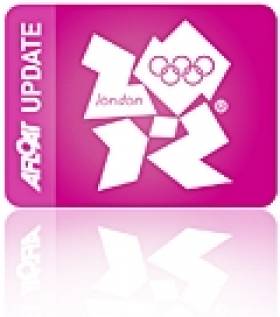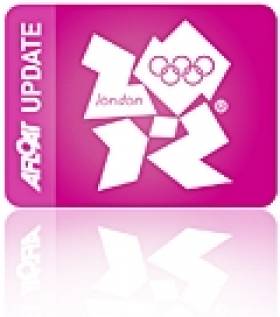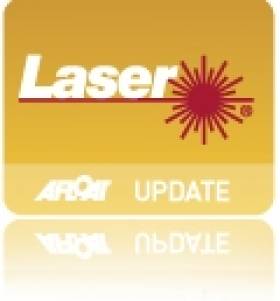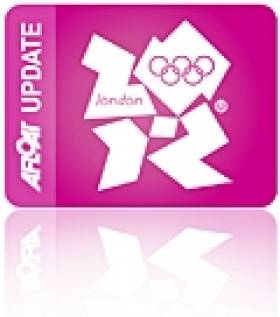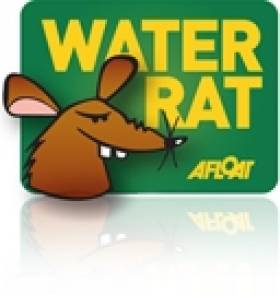Displaying items by tag: Annalise
#LASER RADIAL WORLDS – Another stunning performance by Annalise Murphy at the 133-boat Women's Laser Radial fleet in Boltenhagen, Germany today moves the Dun Laoghaire sailor up to 15th overall and within striking distance of the top ten overall as the Radials finished the last races of their qualifying series today before being divided into the gold and silver fleets for the finals. The choppy waves out on the Wohlenberger Wiek proved challenging and again there were several capsizes.
In the strong winds London Olympic debutante Annalise is showing her strength and repeats her scores from yesterday with a first and second place. Improving twelve places she is now 15th overall due to a rather disastrous first day of racing where she was 65th and 33rd. Similarly the conditions seem to suit Paige Railey (USA) who is only two places and one point behind Murphy with much more stable Top 10 results over the last two days.
The two Finnish competitors seemed to feel right at home and both scored a first and second in today's races. This pushes Sari Multala from fourth to first place overall, three points ahead of Lija Xu (CHN) who is steady in second place. Alison Young from Great Britain drops to third place as the results of a ninth and fourth place in the yellow fleet.
With the exception of the very first race of the qualifying series Marit Bouwmeester (NED), currently seventh overall, is achieving consistent Top 10 results and will be trying to close the twelve point gap between her and Multala in first place during tomorrow's gold fleet races. Josefin Olsson (SWE) who had been working her way up in the results capsized on the last down wind of the second race, losing two points. Righting her boat fast enough meant she still finished eighth in the blue fleet.
In the U21 ranking another American is pushing ahead. Erika Reineke overtook Marie Bolou (FRA) who had been leading throughout the first two days. In third place is Michelle Broekhuizen (NED), who will be racing in gold fleet tomorrow along with the current Top 10 of the U21 competitors.
Results for download in pdf format below.
#OLYMPIC SAILING – London Olympic debutante Annalise Murphy (22) who the Irish Sailing Association (ISA) say can be an Olympic medal winner in Weymouth this summer has had a 'difficult start' to her Laser Radial World Championships in Germany today as extremely shifty winds that increased from eight to twenty knots during the afternoon made racing difficult. Writing on her facebook page last night the UCD Science student told friends: "Tough first day on the water today. #onlyupfromhere!"
In the first race of the Audi sponsored event there was little or no beating in the first leg as the massive 133-boat fleet negotiated big wind shifts. Annalise finished 65th and more problems followed in race two when a collision forced the Dun Laoghaire sailor into a 720 degree penalty turn leaving her 33rd and 103rd overall.
Results sheet is downloadable below as a PDF.
Both starting line and race course had to be repositioned several times and mixed results for the entire fleet reflected the tricky conditions.
Cecilia Carranza Saroli from Argentina achieved the most consistent results with a fifth and a first place. In second place after two qualifying races is Tatiana Drozdovskaya from Belarus with a sixth and a second place. She is followed by Finland's Sari Multala who won the first race and placed eighth in the second.
Favourites Marit Bouwmeester (NED) and Gintare Scheidt (LTU) are in tenth and twelfth place respectively. Vice champion from last year Paige Railey (USA) ended the races on her birthday in 30th place overall. Alison Young (GBR) who won the blue fleet's second race but she finished 31st overall due to a heavy 39 points in the first race.
Leading the Under 21's is Marie Bolou from France with a two point lead over Svenja Weger (GER) and Oren Jacob (ISR), both with 26 points.
Podium Vision for Irish Olympic Sailing Team
#OLYMPIC SAILING – Ireland is on course for an Olympic sailing medal in London according to yesterday's Irish Sailing Association Olympic briefing. The sailing team will be 'on the podium' this summer according to the 'vision' unveiled by team manager James O'Callaghan. All three qualified crew for the Weymouth regatta in 100 days time were at the event held in Jury's hotel, Dublin. O'Callaghan says that the there are nine events left before the Olympics and to be on target for a medal the team, Annalise Murphy, Peter O'Leary and David Burrows and Ryan Seaton and Matt McGovern will need to take six medal race finishes and two medals from these warm up events to stay on target. The ISA also expect at least one more boat to qualify for the Games (from a possible three still campaigning) at next month's final qualification events. Irish Times Sailing Columnist David O'Brien has more on the story this morning here.
Top Five in World Rankings for Murphy and O'Leary/Burrows
#OLYMPIC – Both of Ireland's Olympic sailing contenders are ranked fifth in the latest official world rankings released this evening by International Sailing Federation (ISAF).
Dun Laoghaire's Annalise Murphy is on equal points with world Laser Radial champion Marit Bouwmeester in fourth but the overall rankings leader is Chnia's Lijia Xu.
Mens keelboat pairing Peter O'Leary and David Burrows are also fifth in the Star rankings that is topped by world champions Robert Sheidt and Bruno Prada of Brazil. The ranking result follows a fifth achieved at the Miami Olympic Classes Regatta.
Ireland's 49er pair Ryan Seaton and Matthew McGovern who also qualified for the London Olympics in December last year are now ranked eighth in the world standings.
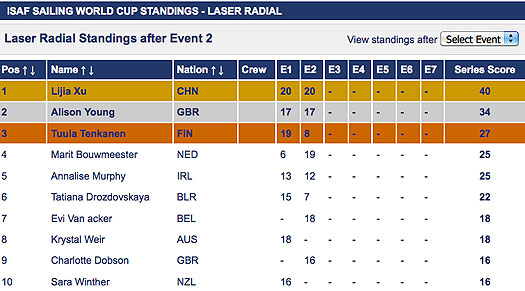

The 2011-2012 ISAF Sailing World Cup standings are starting to take shape after Sail Melbourne and last week's US SAILING's Rolex Miami OCR, the opening two regattas in the seven series World Cup. Annalise finished ninth overall in Miami.
China's Lijia Xu has had the perfect start to her World Cup campaign winning Laser Radial gold at Sail Melbourne and the Rolex Miami OCR. With back to back victories she comfortably leads the Standings and is six points ahead of Alison Young (GBR) who has finished fourth at both World Cup regattas.
Laser Radial silver medallist at Sail Melbourne, Tuula Tenkanen (FIN) has fallen one place following her 13th place in Miami. 2010-2011 Sailing World Cup Laser Radial Champion Marit Bouwmeester (NED) is fourth, trailing Xu by 15 points.
Canada's Lee Parkhill leads the Laser Standings on 25 points and is closely followed by Charlie Buckingham (USA) who is second on 24 points. The Canadian's fifth in Melbourne and 12th in Miami is enough for him to hold an advantage over Buckingham, who came 11th in Melbourne and seventh in Miami, ahead of the third regatta in Palma, Spain.
Beijing 2008 gold medallist, Paul Goodison (GBR) and Laser World Champion, Tom Slingsby (AUS) have a regatta win each and are in third and fourth.
Mathew Belcher and Malcolm Page (AUS) and Stu McNay and Graham Biehl (USA) are locking horns in the Men's 470 with just two points splitting the pair after Miami. The World #1 Australians hold top spot after they won silver in Melbourne and gold in Miami. Belcher and Page have been dominant in the Men's 470 over the last year after World Cup glory and World Championship honours. But McNay and Biehl are pushing them hard early on in the World Cup having won Melbourne gold and finishing fourth in Miami to trail the Australians by a narrow margin.
Americans Amanda Clark and Sarah Lihan lead the Women's 470 on 34 points with Germany's Kathrin Kadelbach and Friedrike Belcher second on 29 points and Rolex Miami OCR winners, Lisa Westerhof and Lobke Berkhout (NED), in third on 20 points.
Sebastian Wang-Hansen (NOR) has had a steady start to the World Cup with a fourth and a third place to his name. The Norwegian leads the Standings on 35 points, seven ahead of Bob Willis (USA) who has been unable to match Wang-Hansen's consistency. Nick Dempsey (GBR) comfortably won gold in Miami after winning 10 of 11 races, he is third on 20 points.
In the Women's RS:X, Demita Vega (MEX) and Jessica Crisp (AUS) are tied on 20 points with one regatta win each to their name and America's Farrah Hall is tied on 19 points with Bryony Shaw (GBR).
Nico Delle-Karth and Nikolaus Resch (AUT) and Nathan Outteridge and Iain Jensen (AUS) top the Standings on 20 points. The Austrians claimed the Miami honours with the Australians taking Sail Melbourne gold before their World Championship win at Perth
Rob Coutts (NZL) leads the Finn class on 22 points but Zach Railey (USA) and Olexsiy Borysov (UKR) are just two points behind him in second and third.
There was no Star and Women's Match Racing competition at Sail Melbourne so sailors got their campaign underway at the Rolex Miami OCR. It was business as usual for Robert Scheidt and Bruno Prada (BRA) who took the Star gold to lead the Standings. And in the Women's Match Racing Lucy Macgregor (GBR) overcame Olivia Price (AUS) in the final in Miami to take an early lead after one regatta.
In the Paralympic Classes, Dan Fitzgibbon and Liesl Tesch (AUS) are tied on 39 points with Alexandra Rickham and Niki Birrell (GBR) in the SKUD. Matthew Bugg (AUS) leads the 2.4mR on 31 points and Udo Hessels, Marcel Van de Veen and Mischa Rossen top the Sonar Standings on 20 points.
The third ISAF Sailing World Cup Regatta, Trofeo S.A.R. Princess Sofia MAPFRE, in Palma, Spain, takes place from 31 March to 7 April.
Annalise Back in Medal Contention with Two More Race Wins
#PERTH2011 – Irish sailor Annalise Murphy needs to beat America's Paige Railey by at least four places to win a bronze medal in tommorrow's Laser Radial final following a stunning performance in Perth today with two further race wins at the ISAF World Championships.
18 knot winds gave the Natonal Yacht Club Sailor (who qualified for the London Olympics this week) the chance to shine again today and significantly narrow the point's gap going in to Sunday's Medal Race.
Murphy Second, O'Leary/Burrows Third in Windy Weymouth
In the Star class, Peter O'Leary and David Burrows are third after four races in the 21–boat keelboat class.
470 veteran Gerbil Owens sailing with Scott Flanigan got off to a flyer at the test event in Weymouth. Scoring a 10th and a 5th on Friday racing the pairing lay in 7th overall but have dropped back to 17th after further rounds at the weekend.
Blustery winds ranging from 19-24 knots welcomed the sailors on the sixth day of sailing at the Weymouth and Portland International Regatta, the Olympic Test Event.
And it was the Australians that excelled throughout the day as Tom Slingsby took the lead in the Laser, Nathan Outteridge and Iain Jensen went ahead in the 49er and Mathew Belcher and Malcolm Page notched up double bullets.
Belcher and Page put their poor start to the regatta behind them as they won both of their races to move up to second overall in the Men’s 470. After the first four races of the regatta the Men’s 470 ISAF Sailing World Cup title holders had a card of 12-11-10-2 and were down by a considerable margin to leaders Pierre Leboucher and Vincent Garos (FRA). But they found their way on the third day of 470 sailing to stay in contention. Belcher said, “It was nice to be racing inside the harbour and to have that experience again. It felt more like our boat today. It felt normal. We settled down a little bit and we are getting used to the Olympic course.”
Overnight leaders Leboucher and Garos (FRA) remain in the lead after they maintained their consistency from the opening two days of racing. They came second in Race 5 and discarded their ninth in Race 6. They lead on 13 points with the Australians in second on 25 points and Japan’s Tetsuya Matsunaga and Kimihiko Imamura are third on 28 points.
In the Women’s 470 Hannah Mills and Saskia Clark (GBR) continue to lead after a steady day on the water. The Brits discarded their eighth in Race 5 before coming second in Race 6 to end the day on 14 points. Ai Kondo and Wakako Tabata (JPN) won Race 5 and came fourth in Race 6 to move from fifth to second overall on 24 points. Gil Cohen and Vered Bouskila (ISR) won Race 6 and jump up to third place.
Outteridge and Jensen (AUS) swapped places with Iker Martinez and Xabier Fernandez (ESP) in the 49er after the Australians recorded their third bullet of the regatta in Race 6. The Australians came fifth in Race 4 and seventh in Race 5 before winning Race 6 by six seconds ahead of Gianfranco Sibello and Pietro Sibello (ITA). On their day Outteridge said, “It was really good for us today. It was really windy and a bit shifty but the flat water was great. We had a shocker in Race 4 but that was down to me as I had a swim. We ended fifth because of that. But it didn’t hurt us too much as the Spanish had two swims.”
Outteridge and Jensen lead on 15 points with the Spaniards, who won Race 4, second on 18 points. Race 5 winners Peter Burling and Blair Tuke (NZL) are third on 21 points after finishing third in the days other two races.
Australia were once again at the top of the podium in the Laser as ISAF Rolex World Sailor of the Year Tom Slingsby (AUS) put in another strong performance. The World #1 came ahead of Rutger Van Schaardenburg (NED) by six seconds in Race 5 but the Dutchman hit back in Race 6 taking a comfortable 31 second victory. Overnight leader Andrew Murdoch (NZL) went 11-4 to slip to second trailing Slingsby by eight points and Van Schaardenburg’s 2-1 moved him from eighth to third overall on 25 points.
World #1 Laser Radial sailor Marit Bouwmeester (NED) continued her fantastic regatta with her third race win and a second. With eight points she leads Annalise Murphy, in second on 26 points, and Krystal Weir (AUS), on 27 points, in third.
Pieter Jan Postma (NED) relished the windy conditions on the Weymouth Bay West course to pick up two convincing race wins in the Finn. The Dutchman won Race 3 by 52 seconds and Race 4 by 16 seconds and is third overall on 17 points. Ben Ainslie (GBR) continues to lead on 14 points despite a 6-5 with Jonathan Lobert (FRA) in second on 14 points. Ainslie maintains his lead after his win in Race 2 but with the discard coming into play tomorrow there may well be changes.
ISAF Sailing World Cup Star title holders Robert Scheidt and Bruno Prada (BRA) once again showed they are the team to beat in the 21-boat Star fleet. The Brazilians went 1-2 to lead on five points. Mark Mendelblatt and Brian Fatih (USA) won Race 4 but are seventh overall on 31 points.
The Brazilians nearest rivals are Poland’s Mateusz Kusznierewicz and Dominik Zycki. The Polish Star sailors are on 19 points and have a long way to go to catch up with the Brazilians.
The Laser, Laser Radial and 470 enjoy a reserve day tomorrow but the 49er, Finn, RS:X and Stars continue racing. Places 5-8 in the Women’s Match Racing will also be decided tomorrow before Tuesday’s Semi Finals.
In his first event sailing in the full rig boat Rush Sailing Club's Alan Ruigrock won the Laser Leinster Championships at the Royal St. George Yacht Club yesterday in some of the finest sailing conditions of the summer so far.
In a combined fleet of 110 boats and southerly winds of 10-15 knots, Ruigrock beat Howth's Ronan Cull and the host club's Conor Byrne who finished second and third respectively.
Annalise Murphy lived up to her billing as top Radial sailor in the country when, in a mixed 40 boat division, she beat Tiffany Brien for the Leinster title. In third place was next week's Irish Youth world's representative Philip Doran of Wexford.
The first 4.7 sailor was Royal Cork's Seafra Guilfoyle. The first master was Gareth Flannigan.
The following from the Class Association:
One hundred and ten sailors competed in the 2011 Laser Leinster Championships which were held in superb summer conditions on July 2nd & 3rd, and were hosted by the Royal St George Yacht Club. The weather did its part to show off Dublin Bay at its best with bright sunshine and a light sea breeze contributing to the regatta atmosphere for the sailors and their families alike.
The sailors needed to display all their skills to achieve a top end result. The wind peaked each day at 10 or 11 knots, with even pressure across the course and only a small number of wind shifts to take advantage of. Wind against tide meant the competitors needed good speed through the light chop. Equally important was a good start, made more difficult by the tide carrying the competitors over the line.
The principal race officer for the weekend was Con Murphy. At the prize giving, Con remarked that although he used a black flag for a number of the races it was great to see the high standard of the sailors meant that not a single person was OCS for the entire regatta.
Seafra Guilfoyle, with four bullets won the Laser 4.7 fleet, adding the Leinsters title to his Munsters and Ulsters trophies. John Durcan was 2nd and Cian Byrne third giving all three top spots to the Royal Cork Yacht Club. Emma Cooney from the NYC won the first lady prize.
The Laser Radial class is where many of Ireland's future Olympic hopefuls race and the Leinsters was no exception. Annalise Murphy of the NYC, "Afloat's May Sailor of the Month" and one of Ireland's strongest medal prospects in the 2012 Olympics won the event in compelling fashion with two firsts and three seconds. Tiffany Brien of Ballyholme YC, fresh from her recent Olympic campaign came in second. Philip Doran of Courtown YC claimed third prize. The prize for the first lady youth went to Sophie Murphy of the home club.
The Laser Standard fleet saw the most intense completion with the last race deciding all three top spots. On the Saturday, Ronan Cull clearly set himself apart winning all three races. At the end of the regatta only three points separated the leaders. Alan Ruigrok of Rush SC won the event, with Ronan Cull of HYC coming second and Conor Byrne claiming third prize for the RSGYC. Ballyholme yacht club also took home some silverware in this fleet with Oliver Loughhead taking the youth prize in fourth place overall and Gareth Flannigan taking the masters prize in 5th place.
Ireland is on the entry list in six classes for the Weymouth and Portland International Sailing Regatta 2011, the London 2012 Olympic Test Event, that has been finalised today.
Ireland's leading hopes for a top result is in the Radial class where Annalise Murphy took bronze at the Sail for Gold regatta at the same venue. There's also high chances in the Star class with Peter O'Leary and David Burrows. Also sailing for Ireland is James Espey is in the Laser, Ross Hamilton in the Finn, Ger Owens and Scott Flannigan in the 470, Ryan Seaton and Matt McGovern in the 49er. A full entry list is available for download at the end of this post.
Sixty six nations have submitted the names of the 460 sailors who will test the conditions at Weymouth and Portland one year ahead of the London 2012 Olympic Sailing Competition.
For many of Member National Authorities there has been a selection headache with nations following game time rules where only one athlete per event is allowed.
In the Finn class Great Britain's Ben Ainslie was selected ahead of Giles Scott and Ed Wright, Spain's Marina Alabau received the nod ahead of Blanca Manchon and Anna Tunnicliffe (USA) lost out to Sally Barkow (USA).
The Women's Match Racers open the Weymouth and Portland International Regatta on 2 August 2011 with the start of their Round Robins. The Men's and Women's RS:X begin on 4 August followed by the Laser, Laser Radial and Men's and Women's 470 on 5 August before the Finn, 49er and Star sailors begin their competition on 6 August.
The London 2012 Olympic Games Sailing Competition will take place at the Weymouth and Portland Sailing Academy and Portland Marina, located in Dorset on the South Coast of England. Racing is scheduled to take place from 29 July to 11 August.At the 2012 Games sailing will introduce women's match racing for the first time. The racing format will be a single round-robin, quarter finals, semi-finals and then the finals. The nine fleet racing events will all sail an opening series before the top ten in each event contest a double-points Medal Race to decide the final positions. The Medal Races have a target time of approximately 30 minutes and will take place close to the shore at the Nothe to allow spectators ashore to get close up to the action.
Are Two Medals a Realistic Expectation from Weymouth?
Afloat opinion: The recent results in World Cup sailing regattas will give rise to considerable optimism in Irish sailing circles that David Wilkins and Jamie Wilkinson's successful performance in the boycott affected 1980 Olympics may be repeated. There have been pretenders to the throne in intervening years – O'Hara, both Lyttles, Mansfield and Burrows are among the names that have quickened the pulses only to be found wanting in the pressure cooker that is the Olympic regatta.
In the previous era there was talk of saving performances for key events – peaking so to say. Nowadays the leading sailors bring their "A" game to every regatta and the consistent nature of the performances being recorded by Annalise Murphy and Peter O'Leary, notwithstanding the changes of crew in the Star class, suggests that this summit has been reached.
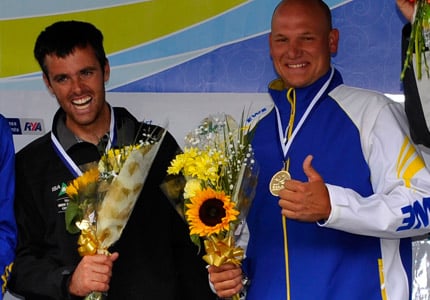
Peter O'Leary (left) wins Gold in 2010. Photo: OnEdition
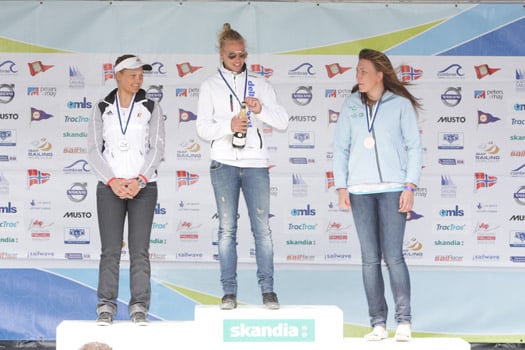
Annalise Murphy (right) wins bronze in 2011. Photo: OnEdition
Murphy's progression in the last few years has been extremely impressive. An eighth place at the Laser Radial Worlds in 2009 preceded a successful period on the Australian circuit with a subsequent progression into the world's top ten. In her last two world cup regattas she has finished fifteen times in the top ten and has won ten races. Her win rate at the Skandia Sail for Gold regatta on the Olympic course was matched only by Ben Ainslie. Inconsistency prevented her from taking first place in both events.
The Star class is studded with achievers, and the top of the fleet is currently littered with Olympic Medallists and World Champions in a number of classes. That the Irish team can compete at this level is beyond doubt, winning at Skandia Sail for Gold last year and finishing 2nd by one point at the Bacardi Cup.
That all three athletes are outstanding sailors may have something to do with their sailing steeped DNA. Additionally, the Star pairing have Olympic experience, although not together. While it may be paradoxical to suggest that in certain circumstances such background and experience might not be 100% positive, the sailing team management will need to set out their stall in an early and positive plan which has buy in from all the connections, clearly defining roles and responsibilities.
The plan must also identify the work necessary to eliminate the inconsistencies that have prevented regular and frequent podium performances. Whether it is course management, tactical decision-making or boat speed (not a problem in certain conditions), it is not a time to be faint hearted in regard to ensuring that the best possible specialist coaches are employed to work on these areas. The ISA management team will need to understand their own strengths and weaknesses, using all the resources available, particularly those provided through the Institute of Sport, so that two medals can be a realistic achievement in Weymouth. Peter, David and Annalise deserve no less.
Comment on this article by writing to us HERE.
All Eyes on Annalise for Laser Radial Medal Race
A shaky penultimate day for Ireland's top performers at the Sail for Gold Regatta sees only Annalise Murphy in medal contention after a 'black flag' penalty cost Peter O'Leary and David Burrows a place in tomorrow morning's medal race.
Murphy, counted her fifth win of the series today to keep third overall and confirm her place in tomorrow's medal race. The Dun Laoghaire single-hander will find it hard to improve on her third overall but in theory she could move up one but she could also still slip out of the medals – as far back as sixth – if tomorrow's race does not go to plan.





























